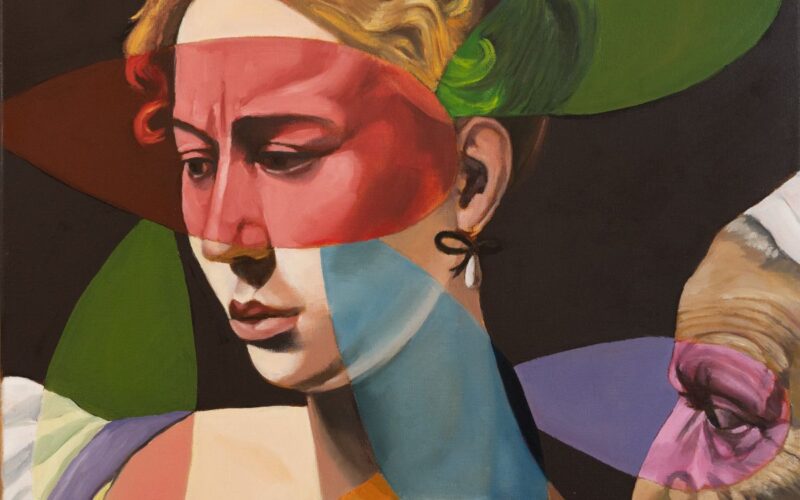It’s an exhibition that gives an insightful look into artist Eric Kaiser’s evolving journey since relocating to Malta at the end of 2022.
At the heart of Smuggler — as the collection is titled — is the motif of the prickly pear cactus, known in Maltese as bajtar tax-xewk. Originally introduced to Malta, yet now deeply embedded in its landscape and cultural identity, this resilient plant serves as a powerful metaphor for adaptation and endurance. Its thick, spiny leaves and vibrant fruit have become a visual shorthand for the Maltese spirit, thriving despite a challenging climate. For Kaiser, the story of the prickly pear resonated deeply with his own experience: that of a foreigner integrating into the Maltese way of life.
Eric Kaiser’s artistic journey in Malta began with his move to a house of character in Balzan, part of which he transformed into his studio. This well-lit space, situated in an alley, with its courtyard and golden limestone walls, provided an ideal setting for inspiration to take root. Immersing himself in the local environment, Kaiser took long, reflective walks through the countryside, observing the island’s distinctive scenery: low rubble walls crisscrossing open fields and small religious shrines marking well-trodden paths at the edges of villages. These elements became focal points in his artistic process, shaping the thematic evolution of his work.
With a background in still life painting, Kaiser seeks to push his practice beyond traditional representations. He is intent on reinventing familiar imagery to provoke curiosity and engagement. The prickly pear cactus, with its bold, iconic form, gradually infiltrated his compositions, transforming them from static studies into dynamic narratives. He found that superimposing the cactus over historical scenes, still lifes, and portraits created an intriguing visual tension.
In many of his works, the prickly pear functions as a veil or filter through which historical imagery is perceived, producing an ethereal effect. It does not always dominate the composition, yet it is always present, subtly reinforcing its symbolic weight. Through this approach, a conversation emerges: between Kaiser and the local landscape and between his work and the cultural significance of the prickly pear itself.
The interplay between the familiar and the unexpected adds depth to his paintings, drawing viewers into a layered dialogue. One of the most thought-provoking sections of Smuggler is Cactus Still-life Religious, where Kaiser explores his impressions of Malta’s strong Catholic traditions. The island’s religious fervour, expressed through its grand churches and elaborate festa celebrations, became a major element for the artist, and a source of inspiration. The result is that Kaiser reimagines classical religious compositions in this series, replacing sacred figures with everyday objects — bleach bottles, spray cans, and dish soap — subverting expectations in a manner that is both playful and reflective.

These works do not seek to mock Maltese culture or diminish the significance of its religious heritage. Rather, they encourage reflection on the coexistence of the sacred and the mundane in everyday life. The bold colours and decorative elements echo the visual exuberance of festa banners (pavaljuni and bandalori), highlighting the duality within Maltese religious expression: a sincere devotion interwoven with an almost theatrical spectacle.
Many of these paintings draw inspiration from iconic Old Master works. For instance, Kaiser reinterprets a detail from Domenico Ghirlandaio’s Nativity, replacing the Christ Child in the manger with a mosquito plug-in device and a roll of tape. Similarly, in the series Cactus Still Life Art History Compositions, he reconstructs historical masterpieces, both religious — such as Velázquez’s Christ at the Column — and secular — such as Greuze’s Septimius Severus and Caracalla — by substituting the original subjects with mundane objects, all partially obscured by cactus leaves.
Kaiser’s use of colour is particularly striking in these works. While sometimes inspired by the palettes of the original compositions, he often employs bold colour blocking and strong contrasts, revealing his affinity and predilection for the hard edge technique. This very precise, geometric approach lends itself particularly well to his reimagined historical paintings.
The Ghost Cactus series takes a different approach, engaging directly with art history and the exhibition’s setting. Here, Kaiser revisits historical masterpieces, including some from MUŻA’s own collection, such as Guido Reni’s Resurrected Christ and works by Mattia Preti. His decision to reference paintings housed within the museum itself fosters a dialogue between past and present. Figures from these classical compositions appear shrouded in the fragmented, geometric patterns of the cactus, blending traditional religious iconography with a contemporary aesthetic. This technique recalls the synthetic Cubism of Georges Braque and Juan Gris, imbuing Kaiser’s work with modern sensibilities while remaining deeply connected to Malta’s artistic heritage.

Shifting focus directly to the plant itself, Cactus Botanic elevates the prickly pear to a subject of contemplation in its own right. Here, the fruit takes centre stage. Its bright pink and orange hues are meticulously rendered with attention to texture and light. These paintings celebrate the inherent beauty of the cactus while drawing parallels to the artist’s personal journey of adaptation. The use of orange, in particular, unifies this series with other works in the exhibition, reinforcing a visual and conceptual cohesion.
In Cactus Faces, Kaiser introduces a human element, incorporating physiognomies from renowned paintings, such as Caravaggio’s Judith Beheading Holofernes. The prickly pear motif overlays these portraits, partially obscuring the figures and lending them an enigmatic quality. In one piece, Judith’s intense gaze is punctuated by a bright pink cactus leaf, a motif that reappears throughout the series, its vivid hue standing out against the muted tones of historical compositions. These paintings further demonstrate Kaiser’s versatility, extending beyond still life into the realms of portraiture and landscape. This interplay of concealment and revelation encourages viewers to see these iconic figures not just as historical artefacts but as part of an ongoing dialogue about identity, transformation, and perception.
While many works in Smuggler are on an intimate scale — measuring 50 x 50 cm — Kaiser also explores larger formats, with some canvases reaching 200 x 120 cm. This variation in scale invites different modes of engagement, allowing viewers to immerse themselves in the intricate details of the smaller pieces while experiencing the full impact of his larger compositions from a distance as well as at close range.
The exhibition’s title, Smuggler, encapsulates Kaiser’s artistic approach. Just as smugglers historically transported goods across borders in secret, Eric Kaiser transports visual and symbolic elements from different periods and traditions into new, unexpected contexts. This theme extends into the exhibition’s installation, where the cactus motif physically encroaches upon the space, reinforcing its presence and significance.
Kaiser’s work becomes a vessel, carrying meanings that transcend time and place, merging his own narrative as an expatriate with the Maltese culture that now surrounds him. The title also reflects his personal experience of relocating to Malta and integrating past artistic influences with new inspirations found on the island.

Throughout Smuggler, Kaiser’s playful yet deeply considered approach is evident. Even in his most provocative works — particularly those in the Cactus Still-life Religious section — his intent is not to offend but to spark dialogue. By juxtaposing the sacred with the everyday and reinterpreting historical art through a Maltese lens, he invites viewers to engage, question, and reflect.
This exhibition represents over two years of dedicated exploration: experimenting, revising, and reimagining. From his first encounters with the prickly pear during countryside walks to the final touches on his canvases, Smuggler is a testament to the power of place, artistic reinvention, and the search for belonging. The latter is a universal human experience and a fundamental human need that everyone experiences at some point in their lives.
Article by Professor Charlene Vella
Smuggler by Erik Kaiser runs at MUŻA from June 20 – July 27










